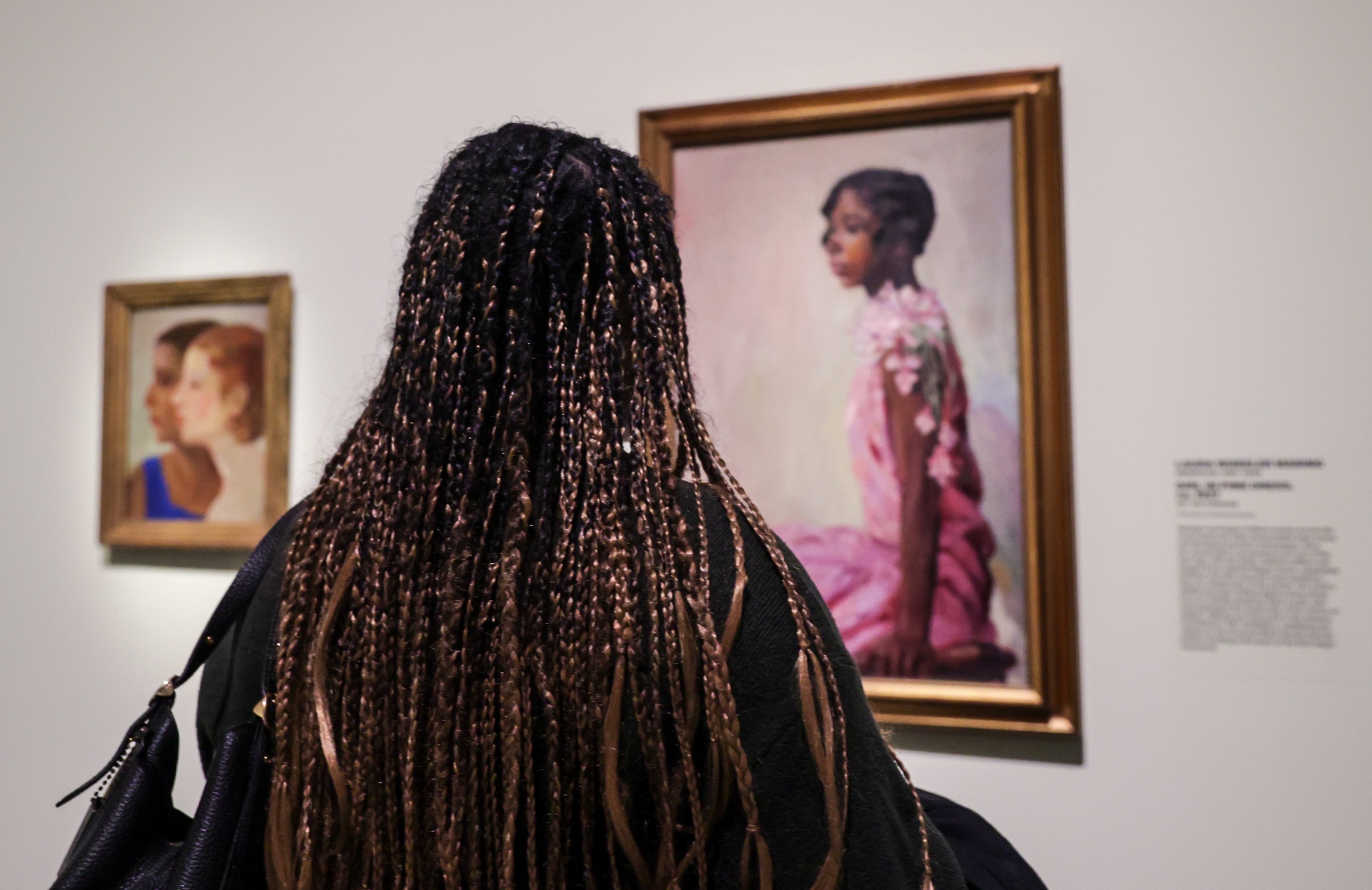Laura Wheeler Waring’s Girl in Pink Dress commanded my attention as soon as I walked into the room at the Met where she was displayed. In a space full of portraits and busts—a room of black faces—hers immediately stood out. Warm and reflective, the gaze of the titular girl is turned away from the perspective of the viewer. Still, there’s something in her upright posture, in the firm set fingers on the wooden stool beneath her, that betrays her awareness that she’s being observed. She’s certainly dressed to be seen. A spray of pink flowers cascades over her brown shoulder. Her hair is delicately, elegantly coiffed. She doesn’t shrink under our observation. Her expression is not one of a girl surveilled. She’s at ease in her finery, at ease being regarded.
Girl in Pink Dress is one of several of Waring’s paintings that were featured in the Metropolitan Museum of Art’s recent exhibition, “The Harlem Renaissance and Transatlantic Modernism,” which ran from February through July of this year. The exhibition is the second of its kind at the Met and can be read as a sort of corrective to the first: the 1969 exhibition “Harlem on My Mind,” which included photographs by the legendary James Van Der Zee but didn’t feature a single painting or sculpture by a black American artist. “Harlem on My Mind” was met with near universal censure by the black artists it claimed to represent, who picketed outside the museum with signs that read “Harlem on Whose Mind?”
It would take over 50 years before the Met attempted a similar project. Neither the new exhibition nor its curator, Denise Murrell, have framed “The Harlem Renaissance and Transatlantic Modernism” as a correction, but it's difficult to imagine it as anything else given that this is only the second time in the museum’s 150-year history that it’s turned its institutional gaze toward a movement that flourished a short train ride away. This show was met with significantly less acrimony, a fact which can be squarely attributed to the diligence of Murrell. Of the 160 paintings, sculptures, and photographs displayed, only 21 of them came from the Met’s permanent collection. As Murrell told the New York Times, “We have such a spotty collection in terms of African American painting and sculpture, like all other [predominantly white institutions].” To capture the vibrancy of the Harlem Renaissance in depth, she turned to the archives of historically black colleges and universities like Howard, Fisk, Clark Atlanta and Hampton while other works, like Waring’s, were sourced much closer to home.
For decades, Waring’s great-niece, Roberta Graves, had been trying to drum up interest from institutions in paintings like Girl in Pink Dress, to no avail. Waring wasn’t entirely unrecognized: Her portrait of opera singer Marian Anderson hangs in the National Portrait Gallery. But her paintings and watercolors of less famous figures languished in the homes of her family. In that same Times article, Graves told journalist Aruna D’Souza that in 2014, “a representative from the Woodmere Art Museum in Philadelphia visited the archive and suggested that, to avoid the headache of trying to find a home for the work, the family ‘might be better off burning’ their Waring holdings.”
It was disappointing to learn about the difficulty that Waring's family faced in posthumously placing her art, if not necessarily surprising. It imbues a certain gravitas in her inclusion in the Met's exhibition, because it's unclear at this point when and where we might see these works again.
Girl in Pink Dress hums with a warm vibrancy. Waring’s dense, visible brushstrokes capture a sort of concealed movement, as if the party this girl is dressed for is happening just beyond the frame, just beyond our view. You can almost see her eyes tracking the movements of the revelers. Still, there’s no hint of impatience in her gaze or her posture. It seems as if she’s not quite ready to join the party, or maybe won't ever be. It’s not clear exactly what she’s thinking. Her pensive expression could be a prelude to a smile, or a sort of wry frown. It’s easy to get lost in Girl in Pink Dress, in the thrilling feeling that if you look long enough, she might just turn her gaze to meet yours. I imagine this party to be a family affair; this girl seems too young to be on her own. Maybe that's why this brief moment of respite seems so welcome. Maybe the party is for her—anyone who's been the center of attention knows how precious a break from the spotlight can be.
Like everybody else who studied abroad in Paris, I have an enduring affection for the work of the Impressionists. Their works were some of the first I was able to recognize, some of the first I felt able to understand without formal training. My fridge is covered in magnetic miniatures of works by Degas and Cezanne and Monet. I fell in love with the way that Impressionism rewards extended viewing—the longer I stood in front of a Pissarro or a Sisley, the more I felt like I could fall forward into the scenes they captured. The landscapes and street scenes were my favorites. The more time I spent in France, the more I’d recognize Montmartre boulevards or the water lilies of Giverny. I couldn’t recognize myself in the figures these artists captured, who were all uniformly white, though that didn’t lessen my enjoyment of their work. Instead, it elicited a sort of idle curiosity—how might skin like mine be rendered in those distinctive palettes.
Maybe that’s why I’ve been thinking of Girl in Pink Dress since I saw her early this spring. So little of black art is about leisure—our pleasure is always political, our rest radical. Waring’s work can’t be separated from that context: Some of her earliest work was producing covers for The Crisis, a publication edited by writer and activist W.E.B. DuBois that provided a sort of clearinghouse for luminaries of the Harlem Renaissance. Still, I'm moved by the lack of urgency in Girl in Pink Dress. There’s a sweet serenity in her expression that reminds me of the space that opens up beneath my ribcage when I see a beautiful landscape, real or fictive. It's a tribute to beauty for the sake of it, a sort of beauty that doesn’t need to be explained or litigated. It just is, obviously, undeniably so.





